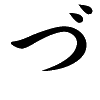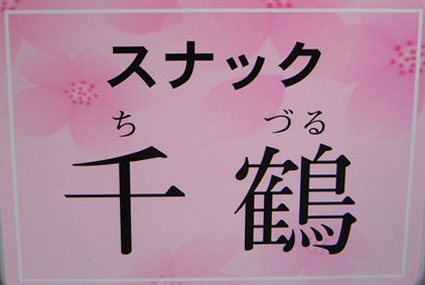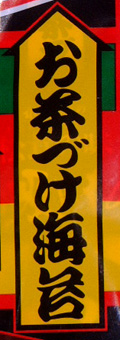
A Couple of Examples of this Hiragana Letter in Actual Use (Public Signs and Labels)
In modern Japanese, the hiragana letter ![]() has exactly the same pronunciation as the hiragana letter
has exactly the same pronunciation as the hiragana letter ![]() ,
that is, 'zu' or 'dzu'. When the kana scripts were reformed after the
Second World War,
,
that is, 'zu' or 'dzu'. When the kana scripts were reformed after the
Second World War, ![]() was
almost completely replaced by
was
almost completely replaced by ![]() -- but not quite. There are still a few words that preserve
-- but not quite. There are still a few words that preserve ![]() as it originally was. Mostly
as it originally was. Mostly ![]() has been retained where a word is etymologically derived by voicing a
has been retained where a word is etymologically derived by voicing a ![]() .
There are also cases where the
.
There are also cases where the ![]() is felt to be the result of reduplicating a
is felt to be the result of reduplicating a ![]() (see examples below).
(see examples below).
If you use a word processor in Japanese, you'll find that typing
Z-U in some cases won't get you the word you are looking for. For instance,
in order to get the verb ![]() tsuzuku, you must type T-U-D-U-K-U (or T-S-U-D-U-K-U)
to get the kana string
tsuzuku, you must type T-U-D-U-K-U (or T-S-U-D-U-K-U)
to get the kana string ![]() ,
which will then convert to
,
which will then convert to ![]() .
Typing T-U-Z-U-K-U will yield
.
Typing T-U-Z-U-K-U will yield ![]() ,
which will NOT convert to
,
which will NOT convert to ![]() .
.
The following are four examples of ![]() from notices, signs, and labels in Japan.
from notices, signs, and labels in Japan.
 Sunakku Chizuru |
|
| This is the sign for a 'sunakku' (snack) or small bar,
named Chizuru ('thousand cranes'). The reason for the |
|
 O-cha-zuke nori |
|
| This is from a packet of cha-zuke nori. The
word cha-zuke is formed from (Note on cha-zuke: A bowl of rice, normally eaten as an accompaniment to a meal, can be converted into a simple meal by pouring hot water and some condiments over the rice. Originally this involved pouring hot tea over the rice, hence the name cha-zuke, 'steeped in tea', but nowadays it's more common to use hot water or broth, topped off with seaweed, tiny rice crackers, salt, etc. The packet shown above contains the topping, mainly nori seaweed; you supply the hot water! The |
|
 Hijoo yobi (?) Hijoo no toki oshitsuzukete kudasai |
|
| This is one of a small number of cases where the sound is felt to be 'reduplicated' -- that is, tuzukeru is felt to have two tsu's in succession. This is the sign on an emergency bell in a train. The meaning is: 'Emergency bell. Press continuously in an emergency'. | |
 Kono kuchi kara ichi-mai zutsu doozo |
|
| As in the above case, zutsu is
felt to be a repeated The word This sign was found in a bank, on a box of tissues used for wiping customers' seals after use (seals or chops are used instead of signatures in Japanese banks). The meaning is 'please take one at a time from this aperture'. |